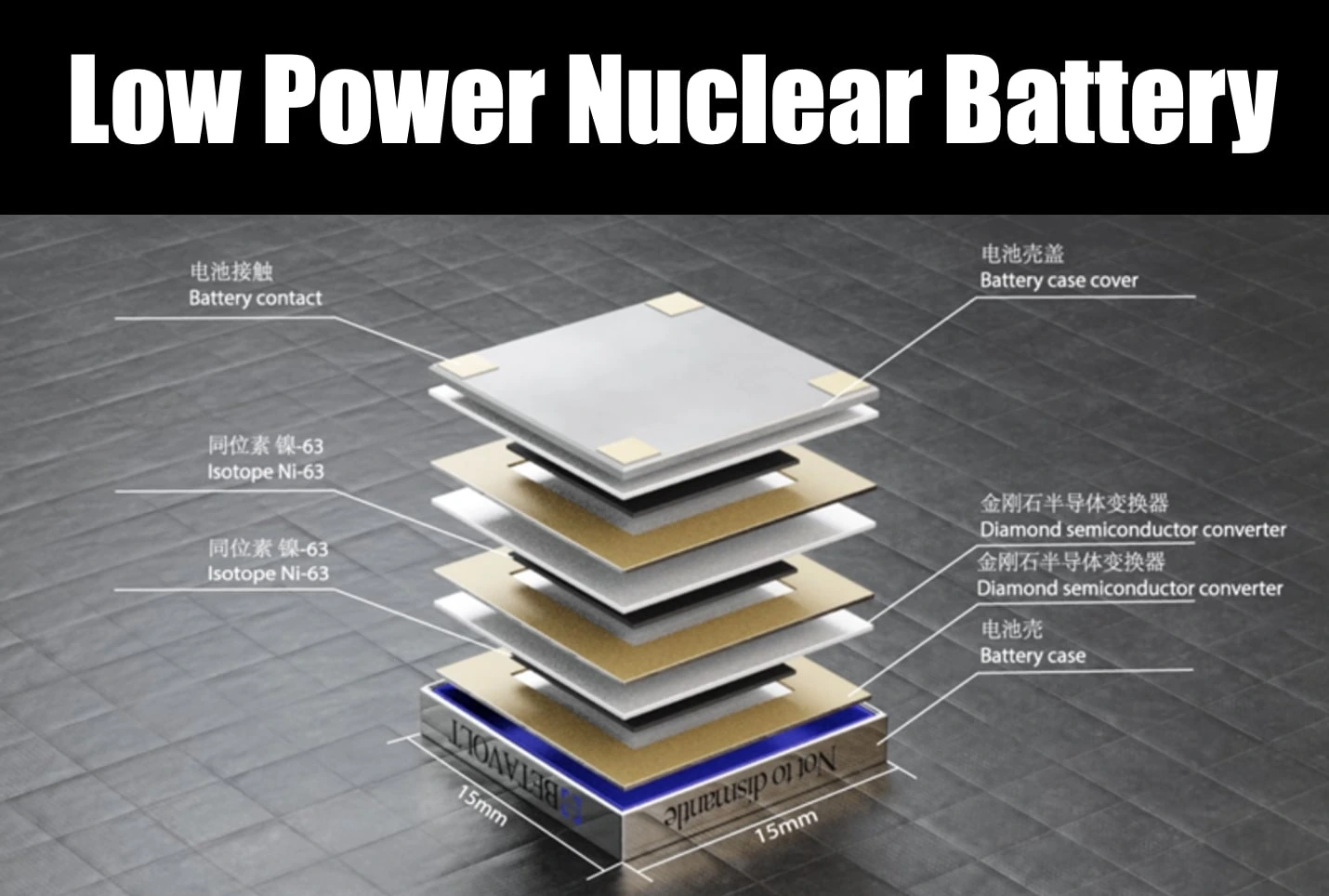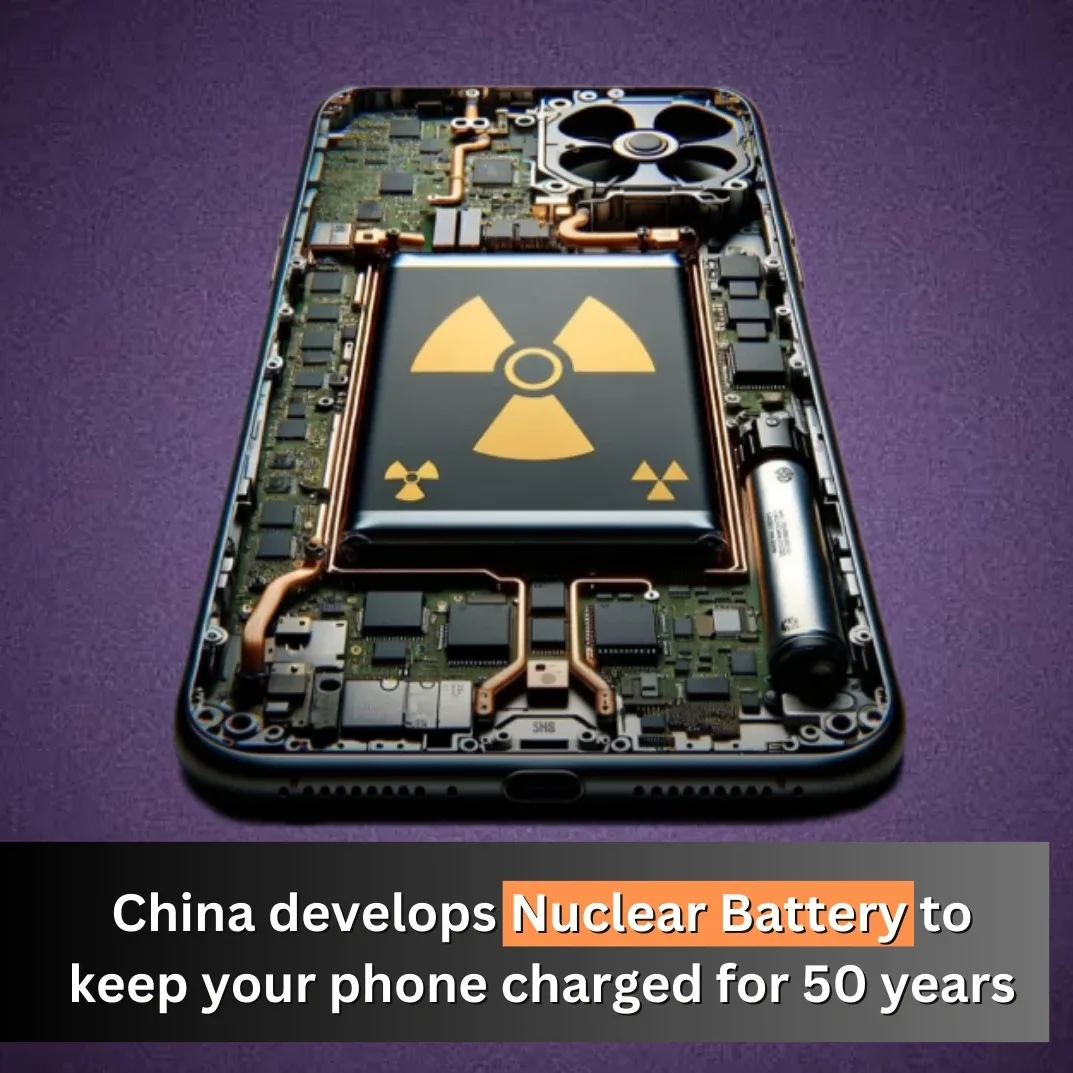China’s groundbreaking nuclear battery is a revolutionary technological marvel that harnesses the power of nuclear energy to generate electricity. Unlike traditional batteries that rely on chemical reactions and require frequent recharging, this futuristic device operates on the principles of nuclear physics. By converting the energy released from radioactive isotopes into usable electrical power, this nuclear battery offers an unprecedented lifespan of 50 years without the need for charging.
The nuclear battery consists of several components that work together to produce electricity. At its core, it contains a small amount of radioactive material, typically an isotope with a long half-life, such as Americium-241 or Plutonium-238. The decay of these radioactive isotopes releases energy in the form of alpha particles, beta particles, and gamma rays. These high-energy particles are then converted into electrical energy using various conversion mechanisms.
One such mechanism is the use of thermophotovoltaic cells, which convert the heat generated by the radioactive decay into electricity. These specialized cells are designed to absorb the high-energy photons emitted during the decay process and convert them into electrons. The electrons are then harnessed to create an electric current, which can be used to power various devices or stored in a conventional battery for later use.
The design of the nuclear battery also incorporates robust shielding to ensure the safety of users and prevent any leakage of radioactive material. Multiple layers of protective materials, such as lead and boron, are used to contain the radioactive isotopes and minimize the release of harmful radiation. This shielding not only safeguards the environment but also ensures the long-term effectiveness and reliability of the battery.
While the concept of using nuclear energy for power generation is not new, this nuclear battery represents a significant advancement in terms of miniaturization and efficiency. By harnessing the immense energy potential of radioactive isotopes, China has pioneered a technology that could revolutionize the way we think about power sources.

Advantages of the nuclear battery technology
China’s groundbreaking nuclear battery technology offers several compelling advantages over traditional battery systems. These advantages make it an attractive option for a wide range of applications, from small electronic devices to large-scale industrial operations. Here are some key benefits of this revolutionary power source:
- Long lifespan: One of the most remarkable features of the nuclear battery is its extended lifespan. With a duration of 50 years without the need for recharging, this technology eliminates the inconvenience of regular battery replacements. The longevity of the nuclear battery not only saves time but also reduces waste and lowers the overall cost of energy production and consumption.
- Reliable power supply: The nuclear battery provides a consistent and reliable power supply. Unlike traditional batteries that gradually lose their charge over time, this innovative technology maintains a steady flow of electricity throughout its lifespan. This reliability is crucial for critical applications where uninterrupted power is essential, such as medical devices and space exploration equipment.
- Energy density: Nuclear batteries have an incredibly high energy density compared to conventional batteries. This means that they can store a significant amount of energy in a compact form, making them ideal for portable devices that require long-lasting power. Additionally, the high energy density allows for more efficient energy storage and utilization, reducing the overall size and weight of the battery system.
- Environmental sustainability: As the world seeks to transition to cleaner and more sustainable energy sources, the nuclear battery presents a promising solution. By harnessing the power of nuclear energy, this technology produces electricity without relying heavily on fossil fuels or contributing to greenhouse gas emissions. The reduced environmental impact of nuclear batteries aligns with global efforts to combat climate change and promote a greener future.
- Versatility: The nuclear battery’s versatility is another significant advantage. It can be used to power a wide range of devices, from smartphones and laptops to electric vehicles and even entire buildings. This adaptability makes it a viable option for various industries and applications, providing a scalable and efficient power solution.
Potential applications of the nuclear battery
The groundbreaking nuclear battery technology developed by China opens up a world of possibilities for its application across different sectors. Its long lifespan, reliability, and energy density make it suitable for a wide range of devices and industries. Here are some potential applications of this revolutionary power source:
- Consumer electronics: The nuclear battery could revolutionize the way we power our smartphones, laptops, and wearable devices. With its extended lifespan, users would no longer have to worry about constantly recharging their devices. This advancement would enhance the convenience and usability of consumer electronics, allowing for more prolonged use without interruptions.
- Medical devices: Nuclear batteries have the potential to transform the medical industry by providing a reliable and long-lasting power source for critical devices. Implantable medical devices, such as pacemakers and insulin pumps, could benefit greatly from the extended lifespan and energy density of nuclear batteries. Patients would no longer need to undergo frequent surgeries to replace batteries or worry about sudden power failures.
- Space exploration: The nuclear battery’s ability to provide a reliable and long-lasting power supply makes it a game-changer for space missions. Current space exploration relies heavily on solar panels and traditional batteries, which have limitations in terms of power generation and storage. By utilizing nuclear batteries, spacecraft and future missions could have a more sustainable and efficient power source, enabling longer missions and expanding the boundaries of space exploration.
- Transportation: Electric vehicles (EVs) are gaining popularity as a more sustainable alternative to traditional combustion engine vehicles. However, one of the main challenges facing EVs is the limited range and the need for frequent recharging. Nuclear batteries could revolutionize the EV industry by providing a long-lasting and reliable power source, eliminating range anxiety and allowing for more extended journeys without the need for frequent charging.
- Remote and off-grid locations: Nuclear batteries could be instrumental in providing power to remote areas and off-grid locations. These areas often face challenges in accessing reliable and sustainable energy sources. The long lifespan and reliability of nuclear batteries make them an ideal solution for powering remote infrastructure, such as weather monitoring stations, telecommunications equipment, and research facilities located in extreme environments.
- Military and defense applications: The military sector could also benefit from the nuclear battery’s advantages. In military operations, reliable and long-lasting power sources are critical for various equipment, ranging from communication devices to surveillance systems. Nuclear batteries offer a viable solution for powering these mission-critical devices, ensuring uninterrupted operation in the field.
Comparison with traditional batteries
The nuclear battery technology developed by China represents a significant departure from traditional battery systems. While both serve the purpose of storing and delivering electrical energy, there are several key differences that set nuclear batteries apart. Here’s a comparison between nuclear batteries and traditional batteries:
1. Lifespan: Traditional batteries, such as lithium-ion and lead-acid batteries, typically have a lifespan ranging from a few months to a few years, depending on usage and maintenance. In contrast, nuclear batteries offer an astonishing lifespan of 50 years without the need for recharging. This longevity eliminates the inconvenience of frequent battery replacements and reduces waste.
2. Energy density: Nuclear batteries have a much higher energy density compared to traditional batteries. This means that they can store significantly more energy in a smaller volume, making them ideal for portable devices and applications where space is limited. Traditional batteries, on the other hand, have lower energy densities, which can result in bulkier and heavier battery systems.
3. Charging requirements: Traditional batteries require regular recharging to replenish their energy storage. This process can be time-consuming and inconvenient, especially for devices that require constant use. Nuclear batteries, however, operate without the need for charging, providing a continuous and reliable power supply for extended periods.
4. Environmental impact: Traditional battery technologies, such as lithium-ion batteries, rely on the extraction and processing of raw materials, some of which are environmentally harmful. Additionally, the disposal of traditional batteries can pose environmental risks due to the presence of toxic chemicals. Nuclear batteries, while not entirely free from environmental considerations, have a reduced environmental impact as they do not rely on resource-intensive materials and do not emit greenhouse gases during operation.
5. Safety considerations: Both traditional batteries and nuclear batteries have safety considerations, albeit of different natures. Traditional batteries can pose risks of overheating, short-circuiting, and chemical leakage, which can lead to fires or explosions. Nuclear batteries, on the other hand, require robust shielding to prevent the release of radioactive material and to ensure the safety of users. The shielding adds an additional layer of complexity and safety measures to the design and operation of nuclear batteries.
While traditional batteries have been the primary power source for many years, the development of nuclear battery technology offers a new and exciting alternative. The extended lifespan, high energy density, and reliability of nuclear batteries make them a compelling choice for various applications, challenging the dominance of traditional batteries in the future.
Development and challenges in implementing the nuclear battery
The development and implementation of nuclear battery technology present both exciting possibilities and unique challenges. While the concept of harnessing nuclear energy for power generation is not new, several factors need to be considered to ensure the safe and effective deployment of nuclear batteries.
1. Research and development: The development of nuclear battery technology requires significant research and development efforts. Scientists and engineers need to explore new materials, optimize designs, and improve conversion mechanisms to enhance the efficiency and reliability of nuclear batteries. Continued investment in research is essential to unlock the full potential of this revolutionary power source.
2. Regulatory considerations: The implementation of nuclear battery technology raises important regulatory considerations. Governments and regulatory bodies need to establish guidelines and safety standards to ensure the safe handling, transportation, and disposal of nuclear batteries. These regulations will play a crucial role in safeguarding the environment and protecting public health.
3. Public perception and acceptance: Nuclear energy, in general, has faced public skepticism and concerns regarding safety and environmental impact. The successful implementation of nuclear battery technology relies on building public trust and confidence in its safety and reliability. Education and awareness campaigns can help address misconceptions and highlight the benefits of this technology.
4. Cost and scalability: As with any new technology, cost and scalability are important factors to consider. The initial development and production of nuclear batteries may be costly due to the specialized materials and manufacturing processes involved. However, with advancements in technology and economies of scale, the cost of nuclear batteries is expected to decrease over time, making them more accessible for various applications.
5. Waste management: The management and disposal of nuclear waste generated by nuclear batteries require careful consideration. While the amount of waste produced by nuclear batteries is minimal compared to other nuclear applications, proper waste management protocols need to be in place to prevent any potential environmental or health risks. Research into efficient waste management strategies is crucial to ensure the sustainability of nuclear battery technology.
Overcoming these challenges will require collaboration between scientists, engineers, policymakers, and the public. By addressing these concerns and investing in research and development, the full potential of nuclear battery technology can be realized, paving the way for a sustainable and reliable power source for the future.
Environmental impact and safety considerations for nuclear battery
The environmental impact and safety considerations associated with nuclear battery technology are of utmost importance. While nuclear batteries offer several advantages, it is crucial to address any potential risks and ensure the safe and responsible use of this innovative power source.
1. Environmental impact: Nuclear battery technology presents a more environmentally friendly alternative to traditional power sources. Unlike fossil fuel-based energy generation, nuclear batteries do not produce greenhouse gas emissions during operation. This reduction in emissions contributes to global efforts to mitigate climate change and transition to cleaner energy sources. However, it is important to note that the production and disposal of nuclear batteries may have environmental implications that need to be managed responsibly.
2. Radioactive material management: The use of radioactive isotopes in nuclear batteries raises concerns about the management and disposal of radioactive materials. While nuclear batteries contain a small amount of radioactive material, it is crucial to handle and store them safely to prevent any potential release or contamination. Strict protocols and regulations must be in place to ensure the safe handling, transportation, and storage of nuclear batteries throughout their lifespan.
3. Shielding and containment: Nuclear batteries require robust shielding and containment mechanisms to prevent the escape of radioactive materials. Multiple layers of shielding, such as lead and boron, are used to minimize radiation leakage and protect users from potential harm. The design and manufacturing of nuclear batteries include stringent safety measures to ensure their effective containment and shielding.
4. Waste management: The disposal of nuclear batteries at the end of their lifespan requires careful consideration. While the amount of radioactive waste generated by nuclear batteries is relatively small compared to other nuclear applications, proper waste management protocols must be in place to prevent any potential environmental or health risks. Research into efficient and safe waste management techniques is crucial to ensure the long-term sustainability of nuclear battery technology.
5. Safety protocols and regulations: The safe operation of nuclear batteries relies on adherence to strict safety protocols and regulations. Governments and regulatory bodies play a crucial role in establishing guidelines and standards for the safe handling, transportation, and use of nuclear batteries. Regular inspections, safety assessments, and training programs are necessary to ensure the proper implementation and operation of nuclear battery technology.
It is essential to prioritize safety and environmental considerations throughout the development, production, and use of nuclear battery technology. By implementing robust safety protocols, adhering to regulatory standards, and promoting responsible waste management practices, the potential risks associated with nuclear batteries can be effectively managed, ensuring a safe and sustainable power source for the future.

Future prospects and potential advancements
The development of China’s groundbreaking nuclear battery technology opens up exciting possibilities for the future of power generation and storage. With ongoing research and development efforts, it is expected that nuclear batteries will continue to evolve and improve in various aspects. Here are some potential advancements and future prospects for this revolutionary power source:
1. Increased efficiency: Researchers are continually exploring ways to enhance the efficiency of nuclear batteries. By optimizing the design and conversion mechanisms, it is possible to improve the energy conversion efficiency of nuclear batteries, resulting in higher power output and improved overall performance.
2. Miniaturization: As technology advances, the miniaturization of nuclear batteries is a possibility. Smaller and more compact nuclear batteries would enable their integration into a wider range of devices and applications, including wearable technology, IoT devices, and even nanotechnology.
3. Enhanced safety features: The safety of nuclear batteries can be further improved through the development of advanced safety features. For instance, researchers are working on self-regulating mechanisms that can automatically shut down the battery in case of any abnormalities or safety risks. These safety features would provide an additional layer of protection and peace of mind for users.
Thank you for joining us on this enlightening journey into the world of long-lasting nuclear batteries. If you found this piece intriguing, don’t miss our captivating analysis between Iran and Pakistan tensions. Your readership is greatly appreciated – stay curious and stay informed!



